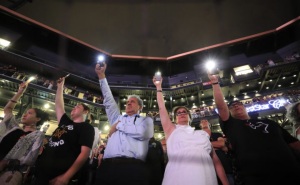Main|Bio|Books|USA Today columns|Opeds|Boston.com blog|Media|Other Publications| Speaking|Links
 Bangor
Daily News
Bangor
Daily News
Mass confusion around mass shootings
By Michael Rocque and James Alan Fox, Opinion guest column August 27, 2019 6:49 amUpdated: August 27, 2019 7:24 am

Jorge Salgado | AP
People hold up their cellphones as the names of the victims of the Aug. 3 mass shooting are read during a memorial service,
Wednesday, Aug. 14, 2019, at Southwest University Park, in El Paso, Texas. Link To The Acual Article:
The first weekend of August bore witness to what is seemingly more commonplace in America, with two mass shootings within successive days that left 31 dead. In our rush to understand and prevent these attacks, there has been a lot of mixing of apples and oranges due to a failure to define mass shootings clearly.
As is generally the case with such horrific displays of random violence, Americans quickly began to seek answers and solutions. The lively debate on various media platforms included a wide range of proposals for stemming the tide of bloodshed -from gun control to immigration reform and from expanded access to mental health treatment to limits on violent video games.
At the same time, of course, others argue vociferously that gun control, immigration, mental illness and violent video games are not the reason why the U.S. has experienced such a high rate of mass shootings, but rather these are little more than "red herrings" and political deflection.
A major problem with this cultural narrative is that we continue to hear disparate statistics on mass shooting based on very different criteria. This has caused mass confusion, if not mass hysteria.
A common and longstanding definition of mass shootings stipulates four or more victims killed in a relatively restricted time period (e.g., 24 hours). A mass public shooting takes place in a public location, as opposed to a private residence and is not tied to any other criminal activity.
Definitions are important. They allow us to distinguish between familicides, for example, and the more fear-inducing public massacres like those that occurred in El Paso and Dayton.
Definitions also allow us to conduct informed research. Claims that there have been 251 mass shootings in 216 days rely on an alternative definition employed by the Gun Violence Archive that only requires four or more people to be shot. In half of these cases, however, no one is killed, and three-quarters include at most one fatality (which may just be the shooter). It is important to differentiate these mass shootings from mass killings, especially when statistics on the former are publicized in the wake of a mass killing. Not doing so makes it easy for people to be misled into believing that mass killings are happening all the time.
In addition, a particularly controversial talking point of late involves whether mental illness can be "blamed" for mass shootings. Some argue that this cannot be so, because other countries have mental illness rates similar to the U.S. but not nearly the same prevalence of mass shootings. Yet, data do suggest that mental illness plays some role in mass shootings, at least those of an indiscriminate nature.
Part of the reason such differing views can co-exist is that we are often not talking about the same thing. For example, in order to dispel the notion that mental illness plays a role in mass shootings, some have pointed to studies of overall gun violence that show little relationship to mental illness. However, it is public rampages as opposed to ordinary gun violence in which mental illness is more apt to be implicated.
Along with criminologist Grant Duwe, we are examining mass public shootings over a 40-year period with one of the end goals to offer publicly available data subject to clear-cut parameters. Using the definition detailed above, we find that mass public shootings have increased in the last two years, but were relatively stable for at least a decade before that. Moreover, from 1976 to 2018, 158 mass public shootings occurred, a far cry from the 500 or more cases other clearinghouses claim.
We do not know whether this increase signals a long-term trend. But one change is clear: the majority of high body count shootings (e.g., at least 20 victims killed) have taken place over the past dozen years.
Definitions matter. It is essential that we compare apples to apples, otherwise contradictory findings will continue to plague our discussions and make it difficult to achieve progress on any preventative measures.
Michael Rocque is an associate professor of Sociology at Bates College and a member of the Scholars Strategy Network. James Alan Fox is the Lipman Professor of Criminology, Law and Public Policy at Northeastern University and co-author of Extreme Killing: Understanding Serial and Mass Murder. SSN members' columns appear in the BDN every other week.